Hello from MID international!
When you hear of “summer in Japan,” you might think of a kimono, called “wasou”

Nowadays, there are various types of wasou’s such as the yukata, jinbei, and samue monk.
All of them are types of a wasou but each has special features.
Here we will talk about how to wear wasou clothes!
What is a wasou?
Originally, wasou was a traditional Japanese style casual wear during the heat of summer.
This has currently become stylish and it has a new purpose.
Now men enjoy “Iki” men’s summer wasou fashion.
Iki means simple, chic and sexy. This is old school tailoring with modern style for a man’s way of life .
Wasou is a very simple style of clothing but it accentuates the face of the person who wears it.
It can fit on every generation and all body types so anyone can enjoy.
Furthermore, it makes you look like the big cheese, your attractive traits are heightened when you dress the wasou well.
After hearing that, why don’t you try “Iki” men’s fashion with the Wasou?
Now, let’s dive into what the differences are between yukata, jinbei, and samue monk!

What is the Yukata, Jinbei, and Samue?
There are yukata, jinbei, and kimono for men’s wasou, but each of them are slightly different.
All wasou are traditional and stylish outfit. You’ll to enjoy wearing wasou for any summers day!
All of traditional yukata, jinbei and samue
Yukata
Yukata is a one piece style kimono.
You must tie an Obi around your waist and wear it like a bathrobe.
It can be worn as everyday clothes and lounge wear.
It is very casual but elegant because it covers up your arms and legs, making it less revealing.
It also goes very well as an outfit for “Omatsuri” a Japanese traditional festival.

Men Big&Tall Yukata with Embroidery Dragon
Jinbei
Jinbei comes with a separate top and pants.
This is mainly worn as summer lounge wear.
It has the shortest sleeves and pants length among all wasou’s.
Especially the shorts give off an active and energetic impression.
Also, the seam from your arms to body is laced-up beautifully.
It can also be worn on an Omatsuri day.
Samue monks
Samue comes with a separate top and pants as well.
However, the top’s sleeves and length are longer than Jinbei and the pants length is basically long.
Originally it was the monk’s working clothes.
Bottoms drawstring hem is one of its features which makes it easy to work and move.
Many skilled laborers still like to wear it.
Furthermore, Yukata and Jinbei are mostly worn in the summer season while Samue fits all seasons.

Firework Print Traditional Samue
How to Dress?
To wear a kimono correctly you want it to be easy to move in but also elegantly beautiful.
Give it a shot! It only gets easier each time that you wear it.
Yukata
1.Put your yukata on.
Pull the sleeves to left and right and align the length of the sleeve.
2.Hold both collar ends together and align the Senui (the centre seam at the back) with the centre of your backbone.
3.Hold each of the collars and wrap right side of the yukata around to the left side of your waist.
Make sure the Senui stays on the center of your backbone.
4.Wrap the left side over the right side of the yukata.
5.To avoid losing the shape, tie Koshihimo (waist rope) around your waist.
Wrap the excess around the rope and straighten the collar.
6.Measure the obi about 30cm (11.8inch) from the end and put a clip there to determine the length of the tesaki.
Fold it in half and place the crease downwards. Place the marking clip front and center.
7.Hold Tesaki with your left hand and wrap the obi around your waist clockwise.
Tighten it lightly after one round.
8.After one more round fold the obi inward and determine the “Tare.”
Tare should be a little bit longer than the Tesaki. The Tesaki should hang over the obi.
9.To check the length of Tesaki and Tare, put them side by side.
10.Cross the Tare over the Tesaki.
11.Tie them tightly.
12.Make a triangle with the Tare.
13.Thread the Tesaki through the triangle’s hole.
14.Pull each of the obi ends gently and check the shape of the completed obi.
*It may cause the shape to collapse if you pull too strongly.
15.With both hands turn the obi clockwise until the obi’s triangle reaches the center of your back.
Finished!
How to Wear YUKATA movie
Jinbei and Samue
1.Put your top and pants on.
2.Wrap the right side so it overlaps around the left side of your waist.
Tie a bow with rope A and B.
Rope A should be on the end of the collar with the right overlap.
Rope B should be around left side of your waist close to the pelvis, inside of the Jinbei.
3.Wrap the left overlap around the right side of your waist.
Tie a bow with the rope C and D. Rope C should be on right side of the Jinbei surface.
Rope D is on the end of the collar on the left overlap.
How to wear a bathrobe?
Just so you know, the way you wear a bathrobe is similar with how you should put on a Jinbei and Samue.

Simply put the bathrobe on, wrap right side of the bathrobe around left side of your waist, and wrap the left side over to the right side of your waist.
Then, tie the robe belt on the belly button but you can also tie it on the side or make a bow tie.
We personally recommend to make it look like a Jedi Knights costume from Star Wars.
Lastly, the fabric of wasou is thin and light so it is perfect for the humid summer.
We hope you will find your favourite and enjoy it this summer!










